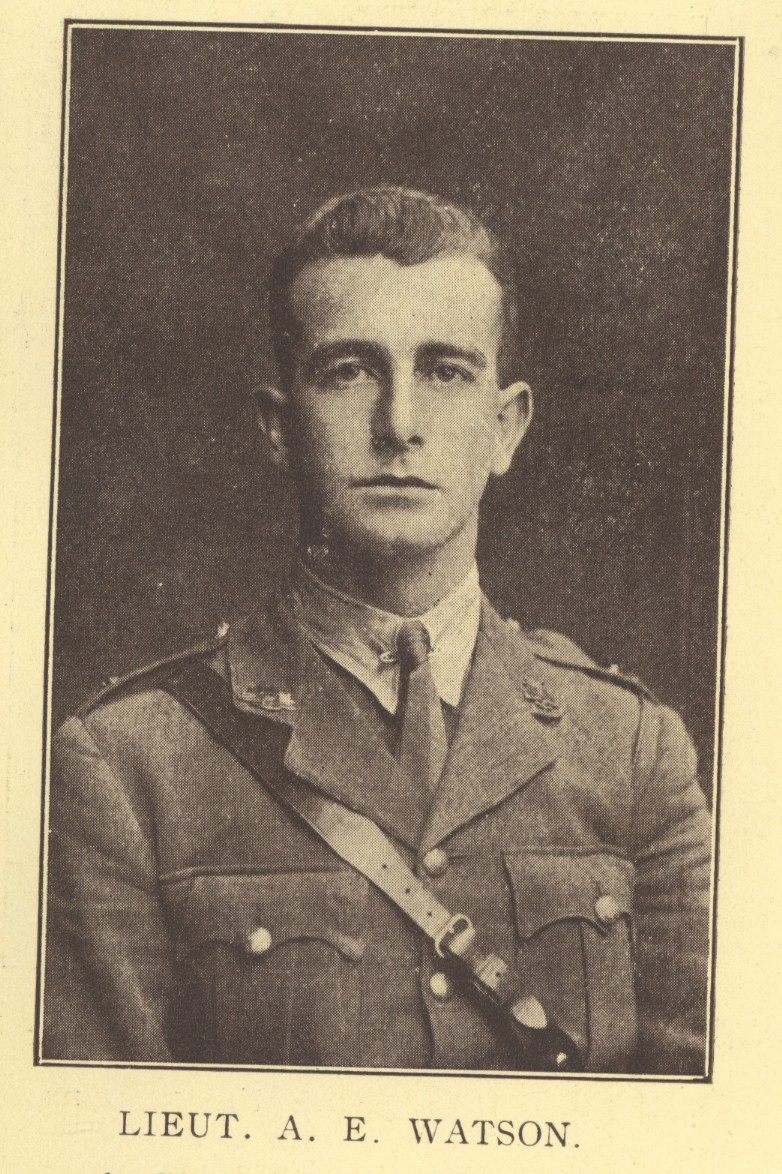2nd Lt
Alfred Edward Watson
Informations sur naissance
|
Date de naissance: 25/06/1893 |
|
Lieu de naissance: Kempsey, New South Wales, Australia |
Informations générales
|
Profession: Étudiant en médecine dentaire |
Informations service militaire
|
Pays: Australia |
|
Force armée: Australian Imperial Force |
|
Rang: Second Lieutenant |
|
Numéro de service: 12085 |
|
Incorporation date: 07/09/1915 |
|
Incorporation nom de lieu: Liverpool, New South Wales, Australia |
|
Unités: — Australian Infantry, 34th Bn. (Dernière unité connue) |
Informations sur décès
|
Date de décès: 13/10/1917 |
|
Lieu de décès: No. 44 Casualty Clearing Station, Nine Elms, Poperinge, Belgique |
|
Cause du décès: Died of wounds (D.O.W.) |
|
Âge: 24 |
Cimetière
|
Nine Elms British Cemetery Parcelle: IV Rangée: F Tombe: 4 |
Distinctions et médailles 2
|
British War Medal Médaille |
|
Victory Medal Médaille |
Points d'intérêt 3
| #1 | Lieu de naissance | ||
| #2 | Lieu d'enrôlement | ||
| #3 | Lieu du décès (approximatif) |
Mon histoire
2nd Lieutenant Alfred Edward Watson
Alfred Watson enlisted on 7 September 1915, with the infantry but was almost immediately posted to a field hospital in Liverpool, New South Wales, until March 1916. He also served briefly with the Dental Corps (presumably because of his dentistry training) before joining the 9th Field Ambulance AIF on 1 April 1916.
He embarked on the troopship Ajana on 1 July 1916 to Britain. After further training he was posted to France in November 1916. He was selected for officer training in March 1917 in England, was promoted to 2nd lieutenant on 30 June 1917 and taken on strength with the 34th Battalion, AIF, on 25 July 1917.
In October 1917 the 34th Battalion (3rd Australian Division, 9th Brigade) took part in the First Battle of Passchendaele on 12 October. The planned advance near Zonnebeke was to the east from Augustus Wood-Ypres-Roulers Railway towards Tiber Copse.
On 11 October the battalion marched along the Ypres-Roulers railway line to its start line by Augustus Wood, with the 35th and 36th Battalions on its right flank. After the battalion reached Zonnebeke Railway Station it was heavily shelled for the rest of its approach. Enemy fire destroyed part of the track and taped line of approach. All three battalions had heavy casualties. The 34th Battalion was on the start line by 2.45am on 12 October.
Alfred Watson was wounded in the head on 11 October as 34th Battalion went to its start line. It is likely that this occurred between Zonnebeke Railway Station and Augustus Wood. He was evacuated by 11th Field Ambulance AIF and transferred to 44th Casualty Clearing Station at Nine Elms, 1 km west of Poperinge. He died there on 13 October 1917 and was buried in the adjacent Nine Elms Military Cemetery.
Alfred Watson enlisted on 7 September 1915, with the infantry but was almost immediately posted to a field hospital in Liverpool, New South Wales, until March 1916. He also served briefly with the Dental Corps (presumably because of his dentistry training) before joining the 9th Field Ambulance AIF on 1 April 1916.
He embarked on the troopship Ajana on 1 July 1916 to Britain. After further training he was posted to France in November 1916. He was selected for officer training in March 1917 in England, was promoted to 2nd lieutenant on 30 June 1917 and taken on strength with the 34th Battalion, AIF, on 25 July 1917.
In October 1917 the 34th Battalion (3rd Australian Division, 9th Brigade) took part in the First Battle of Passchendaele on 12 October. The planned advance near Zonnebeke was to the east from Augustus Wood-Ypres-Roulers Railway towards Tiber Copse.
On 11 October the battalion marched along the Ypres-Roulers railway line to its start line by Augustus Wood, with the 35th and 36th Battalions on its right flank. After the battalion reached Zonnebeke Railway Station it was heavily shelled for the rest of its approach. Enemy fire destroyed part of the track and taped line of approach. All three battalions had heavy casualties. The 34th Battalion was on the start line by 2.45am on 12 October.
Alfred Watson was wounded in the head on 11 October as 34th Battalion went to its start line. It is likely that this occurred between Zonnebeke Railway Station and Augustus Wood. He was evacuated by 11th Field Ambulance AIF and transferred to 44th Casualty Clearing Station at Nine Elms, 1 km west of Poperinge. He died there on 13 October 1917 and was buried in the adjacent Nine Elms Military Cemetery.
Sources 4
|
[s.n.], Short history of the 34th Battalion, AIF, (Uckfield, The Naval & Military Press Ltd, 1957), pg. 22. Sources utilisées |
|
34th Australian Infantry Battalion, (Australian War Memorial, Campbell (AWM), AWM4 23/51/12). https://www.awm.gov.au/collection/C1338583 Sources utilisées |
|
First Australian Imperial Force Personnel Dossiers, 1914-1920, (National Archives of Australia, Canberra (NAA), B2455, WATSON A E). https://recordsearch.naa.gov.au/SearchNRetrieve/Interface/SearchScreens/NameSearch.aspx. Sources utilisées |
|
McCarthy, Chris, The Third Ypres : Passchendaele, the day-by-day account, (London, Arms and Armour, 1995), pg. 113-114. Sources utilisées |
Complément d’informations 3
|
Commonwealth War Graves Commission Database https://www.cwgc.org/find-records/find-war-dead/casualty-details/137670 |
|
Namenlijst (In Flanders Fields Museum) https://namenlijst.org/publicsearch/#/person/_id=dda25234-f7d0-4dfa-b1e1-072e0f8fe0c1 |
|
Lives of the First World War (Imperial War Museum) https://livesofthefirstworldwar.iwm.org.uk/lifestory/7296069 |
